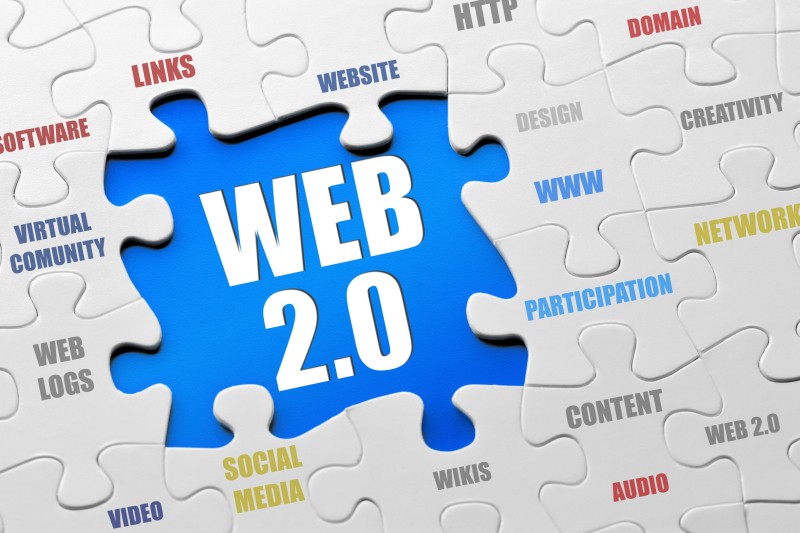What is Web 2.0… and Web 3.0?
 This was actually an assignment in class… But I really liked it and accidentally wrote it in blog style, so here it comes!
This was actually an assignment in class… But I really liked it and accidentally wrote it in blog style, so here it comes!
It seems that merely a decade ago, people are satisfied with websites whose sole purpose is to distribute and display information. Websites were static, seldom updated (unless you are a geek who spends 20 hours of your day on your website alone) and requires learning the HTML codes to write (again, for geeks who know codes.) Average users, at best, can create a static page that shows some pictures, texts, and maybe a music or two in the background. Web development were completely done by software developers (super geeks), and users could not contribute to the site.
Enter the age of web 2.0, a vague idea that began within in the recent past that instantly became a reality. The web 2.0 increased communication between websites and users, and websites are no longer static. The contents become user-generated, with information shared by one person and collaborated by many people. Users who do not understand codes (a.k.a., non-geeks) can began creating informational, innovative, and active websites that can collaborate and interact with their audiences. Web 2.0 provided a platform of enhanced creativity, and encouraged collaboration among people. It is customizable, interactive, collaborative, and shareable, and tend to be public by default.
The popular web 2.0 technologies include, but not limited to the following:
- blogs (Blogspot)
- RSS
- microblogging (Twitter, Plurk)
- Social Bookmarking (de.li.cious, Digg, Stumble)
- Wikis (Wikispaces, Wetpaint)
- web applications (GoogleDocs, SlideShare, st)
- social networks (Facebook, MySpace)
- video sharing (Youtube, Teachertube)
- …..and much more.
The allure of web 2.0 applications and websites are that they are often user-centered, easy to learn, and free. It has opened the internet world to a wider public, and allow people to share as well as explore.
Enter the world of web 3.0. While many people believe it is still far in the future (since most people have just get acquainted with web 2.0,) web 3.0 has already infiltrated our daily life in our normal use of internet. Companies such as Amazon and Google has been actively using web 3.0 to attract customers, and Facebook’s recent rendition of the “pages” has pushed web 3.0 to a new height and awareness. Through the use of rating systems and products you’ve accessed, e-mail subject scanning, the frequency of the music you are listening to, and the “Like” button, the web is actively learning the preferences of the user and providing contents that would most be most appealing to the user. The internet is evolving around the user, and ultimately would expand to appliances and other daily gadgets people use.
For many people, Web 3.0 is often called the Semantic Web, which, in essence, is a place where search engines and software agents can better troll the Net and find what users are looking for. According to Nova Spivack, the CEO of Radar Networks, one of the leading voices of Web 3.0 , it is a “set of standards that turns the Web into one big database.”
While the concept continues to be criticized, there are some basic concepts of Web 3.0 are:
Semantic Web – a web where machines read sites similar to humans, and seek out information based on the users’ set criteria to produce optimal result. For example, the computer may check the person’s schedule against the available appointment schedule of all dentists around the person in a 10-mile radius.
3D Web – a web where it provides virtual reality surfing similar to that of 3D video games or movies, giving viewers a more dynamic and realistic experience while viewing the site’s material.
Media-Centric Web – a web where one uses a media to find other media, thereby eliminating the use of keywords and the frustration of not knowing what to use to find the information you need. One of the ideas within this concept is the Augmented Reality, where users can use their cellphone to take a picture of the neighborhood, and access the web to search for information regarding this particular location. It increases the accuracy and eliminates wait time or guessing.
All-encompassing Web – or as PC Mag calls it, the “pervasive web”, a web that is everywhere and surrounds every aspects of one’s life. Appliances, not just computers, can be programmed and connected to the web, and provide a more luxurious, anticipatory lifestyle to people.
While the definition of Web 3.0 is still evolving, and the concept is not definitive yet, many of the possibilities that are being discussed right now among leading developers are exciting and creative. Though the technology will always have their critics just like the Web 2.0, I think we can expect to start seeing Web 3.0 taking its solid shape and entering our lives in the very near future.
Sources Cited –
- http://prezi.com/dtojoyvwgffj/what-is-web-20/
- http://prezi.com/kpe9mkxs0eft/what-is-web-20/
- http://www.youtube.com/watch?v=bsNcjya56v8&feature=related
- http://www.pcmag.com/article2/0,2817,2102852,00.asp
- http://www.commoncraft.com/augmented-reality-video

